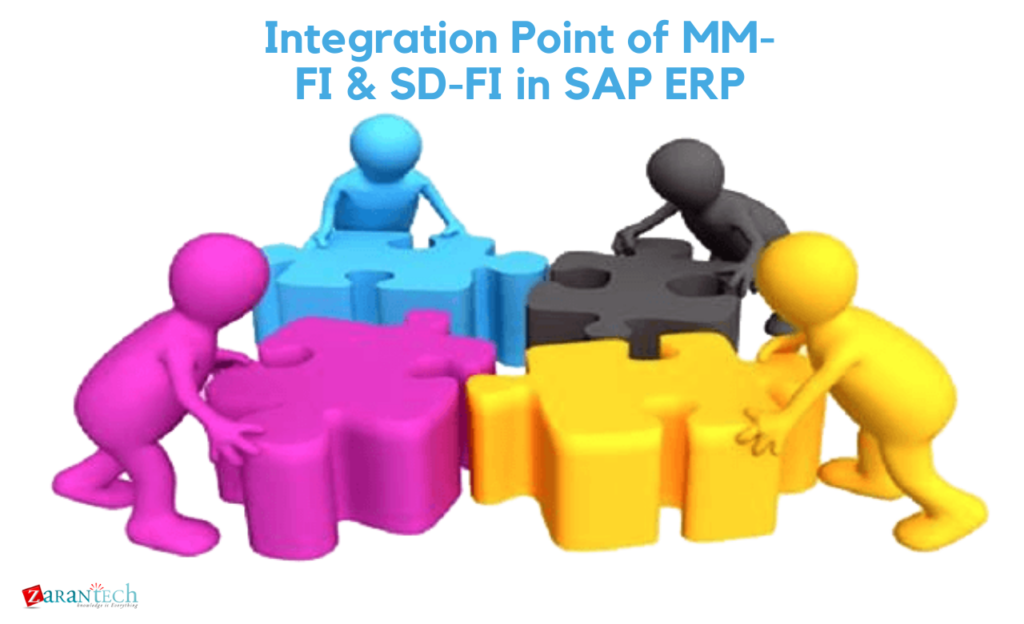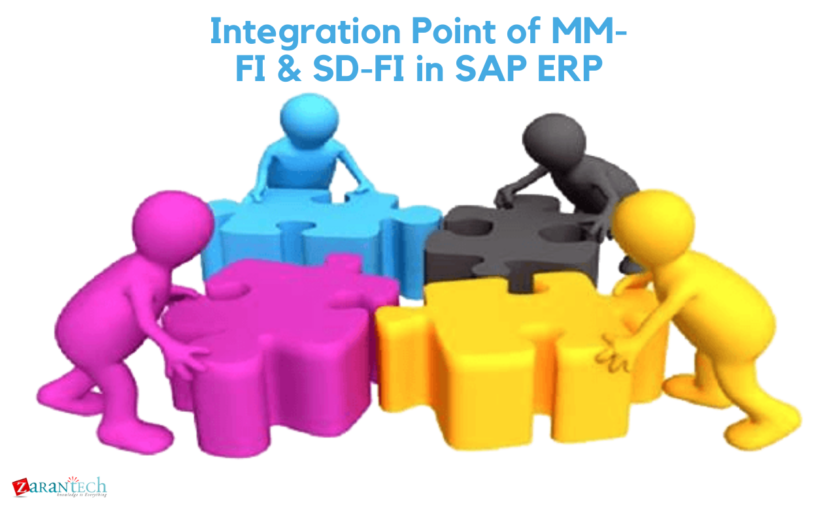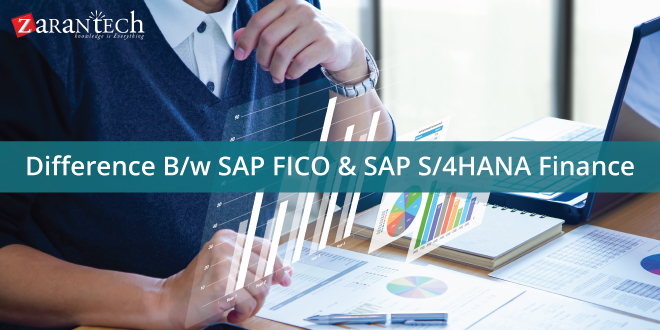Integration Point of MM-FI & SD-FI in SAP ERP
Category: SAP FICO Posted:May 28, 2020 By: Robert
SAP MM FI integration is a good example of how different modules of SAP ERP systems are integrated with each other. SAP ensures that data from one module automatically flows to another module.
MM Module means procure to pay process, FI module indicates financial statement and payment procedure, the SD Module implies sale to consumer procedure.
The majority of the manufacturing business logic is represented by three points BUY-MAKE-SALE.
Click here to Boost Your Skills In SAP
MM-FI Integration
In this part, we learn about MM-FI Integration Factors. When we do a movement for material, if the movement is account effective, then it will post an account entry in FI.
Here I will discuss how the accounting entry is posted and how you can do the configuration. We have material master data in our procurement procedure. In material master, we kept all information for a certain material. Like material type, material group, purchasing information, Sale and Distribution details, etc.
The valuation class (in accounting 1 view) is most important for automatic account posting purposes. We can see the valuation class for individual material from t-code MM03.
The Valuation class is used to group together numerous materials with their same attributes, to ensure that we can bring the same account determination for numerous materials. Every material has a valuation class, lots of materials can contain the same valuation class. The valuation class is linked with material type using account category reference. You will find in the blog article about material type, account category referral as well as valuation class.
The valuation class will be for Raw Material, Semi-finished, finished goods. We can distinguish valuation class as per our business requirement. valuation class and Movement type are used for the G/L determination. Movement type is used for all kinds of material movement. Suppose if you get material from a vendor, a movement happens for the movement. If we transfer material from one area to another, a movement type occurs for the movement. It means, whenever we do an off-setting entry, a movement type will be developed for that. For different movement types SAP specifies a G/L Account for the material movement.
Let’s discuss an account entry for a movement type. When we do a goods receipt, the movement type that happens is 101. And SAP designed according to business procedure the account entry will:
Inventory A/C debit
GR/IR A/C credit
We know about these accounts, Inventory A/C for material master and GR/IR Account is a provision account vendor. All account entry is done via automatic account posting.
SPRO-IMG-MM-Valuation as well as Account Assignment-Account Determination-Account Determination Without Wizard-Configure Automatic Postings (t-code OMWB).
Direct t-code OBYC.
For different movement types, the account entry is done using a different transaction event key.
For eg.
- If any movement type hits the inventory entry then it will hit the BSX Transaction event key.
- If any movement type hits the off-settings entry after that it hits the GBB Transaction event key.
- If any movement type hits the provision entry then it hits the WRX transaction event key.
- If you observe the transaction key GBB, after that you can find a lot of account modifiers are utilized for various movement types.
We can not remember all account modifiers at all, for this objective SAP present Simulation Mode. Using simulation mode, you can easily identify the account modifier which is utilized for GBB.
Path = SPRO-IMG-Materials Management-Valuation and Account Assignment-Account Determination-Account Determination Without Wizard-Configure Automatic Postings.
T-code OMWB.
Establish the simulation criteria according to your need.
Establish the Application Location, Input Mode, Account Inspect. Then press simulation.
You can see all G/L account uses with all transaction event keys and account modifiers for this particular movement type. By doing this when we post a movement type in MM Module, it is also updated in the FI module. In other words, we can say the main point of MM-FI Integration in OBYC.
From MM side itsValuation class and for FI side its G/L account. When we do a movement type, the movement type finds the valuation class for the material, and post the amount to this G/L account which is assigned to this particular valuation class.
Want To Dive Deeper into SAP Topic? Click here
SD-FI Integration
In this part, we find out about SD and FI integration points.
Whenever we sell a finished material to a customer, then the customer has to pay for that. The organization sends out a bill to the customer. Because setting all billing documents which happen to the Sales and Distribution Module will be posted into the FI Module. The account entry of regard to billing always has 2 sides. One side is the Customer account and the other side is the revenue account.
For instance:
Consumer A/c Debit
Revenue A/c Credit.
According to the SD Module, the consumer account will be selected from customer master data, which is maintained from the SD module. We simply require setting up the revenue account and if there are any type of discount and surcharges account. We have to do that using the access sequence is only an SAP term to identify the G/L accounts.
SAP supplies 5 methods to identify G/L accounts in the SD module.
These are:
1 Cust.Grp/ MaterialGrp/AcctKey.
2 Cust.Grp/ Account Key.
3 Material Grp/Acct Key.
4 General.
5 Acct Key.
The assigned G/L accounts are used to post the discount and revenue and any kind of surcharges.
To configure this.
Go to Path = SPRO-IMG-Sales and Distribution-Basic Functions-Account Assignment/Costing-Revenue Account Determination-Assign G/L Accounts
T-code = VKOA.
You can see the below screen and you can also see the default table and description for the above 5 methods.
The first system checks the first table entry Cust.Grp/ MaterialGrp/AcctKey. If any G/L kept hereafter that system will go to the transaction and the particular billing document after that system searches the combination of customer group as well as the material group. If the system will find any G/L after that system will go through the G/L if the system doesn’t find the G/L, after that it will search the following table.
The customer group is preserved in Customer Master Data, Material Group is maintained in Material Master Data, Account key is preserved for condition type in pricing procedure.
Let’s maintain One G/L account for material group and account key combination.
Double click on the Material Grp/Acct Key.
I have actually preserved the G/L for this combination. below AAG is the material grp. Whenever the system searches the table and finds the combination for the transaction, then the system will debit the customer account and credit to this account (180033 ).
The account key identifies that it is a revenue or discount or surcharges.
Press F4 on the Account Key field, you can see all the account keys. The account keys are also maintained in the calculation schema in the Pricing process.
Path = SPRO-IMG-Sales and Distribution-Basic Functions-Pricing-Pricing Control-Define And Assign Pricing Procedures-Maintain pricing procedures.
By doing this SD and FI are integrated with each other.
Conclusion
MM and SD interaction take the scenario of a third party order process. This process uses a purchase order (which is sent to your vendor). Also, billing verification is used further along the process to check that the bill you send to your customer is the same material and quantity as that which the vendor sends to you.
I hope that by now you have had an overview of SAP FICO. Before you enroll in ZaranTech’s certification course on SAP FICO do check out this demo video





 99999999 (Toll Free)
99999999 (Toll Free)  +91 9999999
+91 9999999